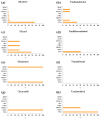New Challenges in Tumor Mutation Heterogeneity in Advanced Ovarian Cancer by a Targeted Next-Generation Sequencing (NGS) Approach
- PMID: 31197119
- PMCID: PMC6627128
- DOI: 10.3390/cells8060584
New Challenges in Tumor Mutation Heterogeneity in Advanced Ovarian Cancer by a Targeted Next-Generation Sequencing (NGS) Approach
Abstract
Next-generation sequencing (NGS) technology has advanced knowledge of the genomic landscape of ovarian cancer, leading to an innovative molecular classification of the disease. However, patient survival and response to platinum-based treatments are still not predictable based on the tumor genetic profile. This retrospective study characterized the repertoire of somatic mutations in advanced ovarian cancer to identify tumor genetic markers predictive of platinum chemo-resistance and prognosis. Using targeted NGS, 79 primary advanced (III-IV stage, tumor grade G2-3) ovarian cancer tumors, including 64 high-grade serous ovarian cancers (HGSOCs), were screened with a 26 cancer-genes panel. Patients, enrolled between 1995 and 2011, underwent primary debulking surgery (PDS) with optimal residual disease (RD < 1 cm) and platinum-based chemotherapy as first-line treatment. We found a heterogeneous mutational landscape in some uncommon ovarian histotypes and in HGSOC tumor samples with relevance in predicting platinum sensitivity. In particular, we identified a poor prognostic signature in patients with HGSOC harboring concurrent mutations in two driver actionable genes of the panel. The tumor heterogeneity described, sheds light on the translational potential of targeted NGS approach for the identification of subgroups of patients with distinct therapeutic vulnerabilities, that are modulated by the specific mutational profile expressed by the ovarian tumor.
Keywords: HGSOC; NGS; TP53; advanced ovarian cancer; concurrent somatic mutations; driver actionable genes; platinum sensitivity; translational medicine; tumor profile.
Conflict of interest statement
The authors declare no conflict of interest. The funders had no role in the design of the study; in the collection, analyses, or interpretation of data; in the writing of the manuscript; or in the decision to publish the results.
Figures




References
-
- World Health Organization (WHO) Mortality Database Health Statistics and Information Systems. WHO; Geneva, Switzerland: 2017. [(accessed on 15 October 2017)]. Available online: http://www.who.int/healthinfo/statistics/mortality_rawdata/en/
-
- Raja F.A., Counsell N., Colombo N., Pfisterer J., du Bois A., Parmar M.K., Vergote I.B., Gonzalez-Martin A., Alberts D.S., Plante M., et al. Platinum versus platinum-combination chemotherapy in platinum-sensitive recurrent ovarian cancer: A meta-analysis using individual patient data. Ann. Oncol. 2013;24:3028–3034. doi: 10.1093/annonc/mdt406. - DOI - PubMed
-
- Horowitz N.S., Larry Maxwell G., Miller A., Hamilton C.A., Rungruang B., Rodriguez N., Richard S.D., Krivak T.C., Fowler J.M., Mutch D.G., et al. Predictive modeling for determination of microscopic residual disease at primary cytoreduction: An NRG Oncology/Gynecologic Oncology Group 182 Study. Gynecol. Oncol. 2018;148:49–55. doi: 10.1016/j.ygyno.2017.10.011. - DOI - PMC - PubMed
Publication types
MeSH terms
Substances
LinkOut - more resources
Full Text Sources
Medical
Research Materials
Miscellaneous

